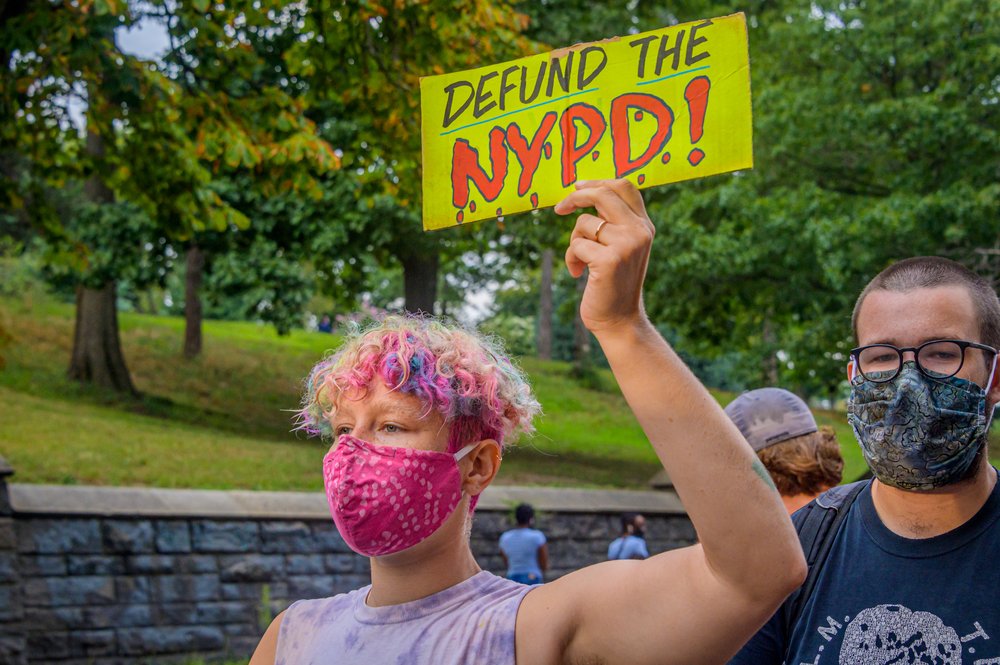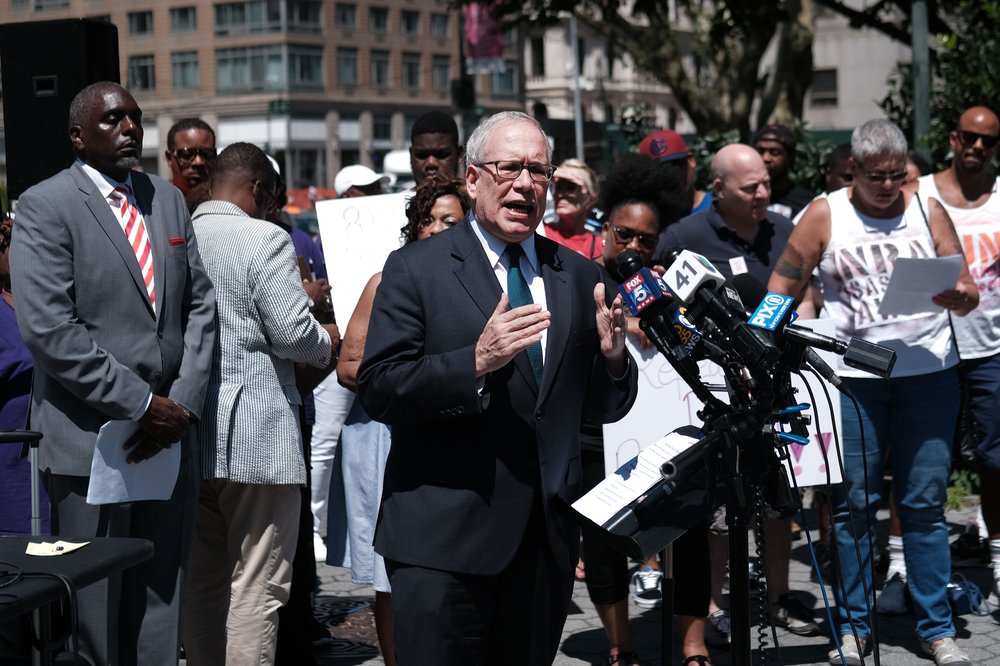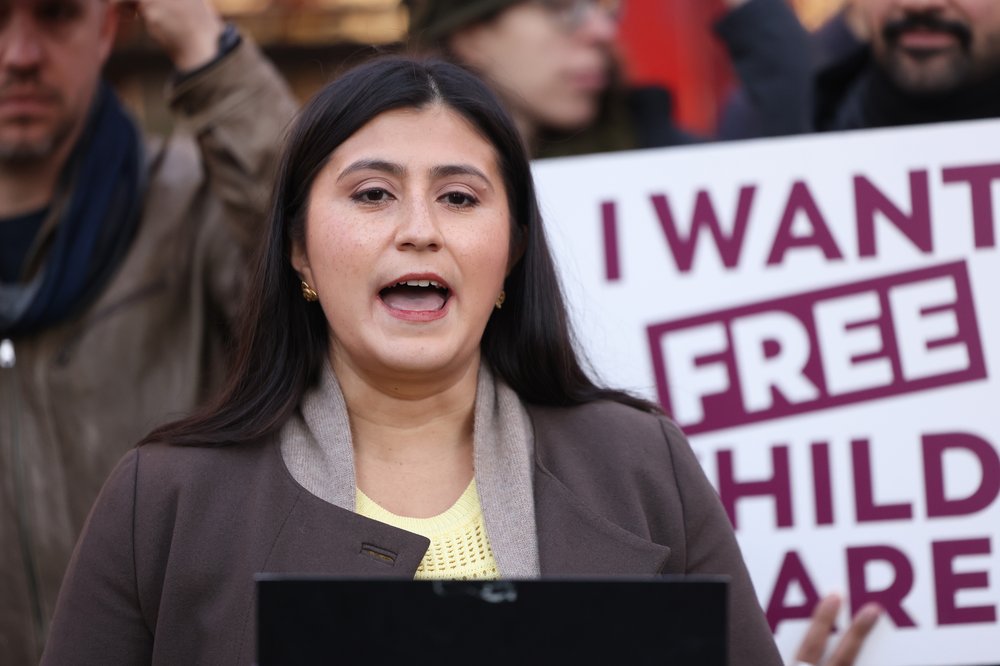Liberal mayoral candidates ditch 'defund police' amid NYC public safety angst
Jan. 28, 2025, 10:50 a.m.
Comptroller Brad Lander called the defund movement "a failed political strategy."

As crime remains a top concern for voters, Democrats running to unseat Mayor Eric Adams are jockeying to convince the electorate they can deliver on public safety — while distancing themselves from calls to “defund the police.”
The slogan, which served as shorthand for cutting law enforcement budgets and investing in criminal justice alternatives, gained momentum amid nationwide protests over police brutality. But the defund movement has faced backlash from conservatives and moderates who say it alienated voters alarmed by a pandemic-era rise in crime.
Now, several of Adams’ challengers who embraced calls to reimagine policing after the killing of George Floyd in 2020 are staking out more pro-police positions, signaling that the issue will likely be at the center of the mayoral race.
Scott Stringer and Brad Lander, the former and current city comptroller respectively, both supported cuts to police funding in 2020. But Lander recently said in an interview that the defund movement was a “failed political strategy,” while Stringer kicked off his official campaign this month by announcing he’d hire 3,000 additional NYPD officers.
Adams, who has been a staunch supporter of police throughout his first term, has seized on the shift.
“I'm not like other people who call for just defunding the police department and now have a different belief about funding the police department,” Adams said this month about his opponents. “I'm going to keep New Yorkers safe.”

Whitney Tilson, a former hedge fund manager also running in the primary, called “defund the police” the “three dumbest words of all time.”
The public safety debate comes after a national election where Republicans successfully campaigned on pledges to crack down on crime and disorder and made inroads in New York City.
Polls show that many New York voters continue to view the city as unsafe, despite a steady decline in the overall crime rate. A New York Times-Siena survey last October found that more than a quarter of New York City voters said crime was currently the most important problem facing the city. Those fears have contributed to low approval ratings for Adams, who’s facing federal corruption charges, and Gov. Kathy Hochul, a moderate Democrat who is expected to face competitive challenges from both parties in 2026.
State Sen. Zellnor Myrie, another mayoral candidate, joined calls to transform policing in 2020. At that time, Myrie said police brutality was "in the DNA of this country” and sued the NYPD after police pepper sprayed and beat him during a demonstration.
Now, Myrie is running for mayor and talking about the importance of policing by invoking his mother, who was once robbed at gunpoint. He often shares her remark that “feeling safe means seeing a police officer.”
Democratic political strategist Chris Coffey said that voters’ perceptions of crime and disorder are informing the candidates’ evolving positions.
“We know that in polls, folks are choosing public safety and the feeling the city isn’t being managed well,” Coffey said.
“If that's what the issue is in June when they're voting, it very much favors the moderate in the race.”
Adams, a former NYPD captain, has been a champion of the department, and joined the crowd of law enforcement personnel who escorted suspect Luigi Mangione in handcuffs after the fatal shooting of a health insurance CEO. Adams wore a bulletproof vest to join officers in a raid on a suspected migrant crime ring last year.
But some observers have criticized events like the Mangione perp walk as mere publicity stunts. And Coffey said the focus on law and order could also help Andrew Cuomo, who has yet to declare his candidacy but has nevertheless cast a shadow over the mayoral contest.

As governor, Cuomo signed the 2019 criminal justice reforms that ended cash bail for many nonviolent defendants, but he also clashed with more liberal Democrats to expand the list of bail-eligible crimes the following year. He also waded into the issues of homelessness and disorder on the subway system, issuing an unprecedented order to shut down the trains overnight for cleaning during the pandemic.
“Andrew will likely be in the race and that will obviously change the trajectory,” Coffey said.
At least one Democrat running for Adams’ job has maintained his criticism of the NYPD.
“We are led at the city and state level by executives for whom no matter the question, the answer seems to always be more police,” said Zohran Mamdani, a state assemblymember from Queens. “We are seldom given any other option.”
Mamdani, a democratic socialist, is the most left-leaning candidate in the race. He criticized the rise in illegal stop-and-frisk tactics under Adams, which disproportionately target Black and Latino men.
Although he did not directly answer the question of whether he would cut police funding, he pledged to eliminate the NYPD’s strategic response group. Mamdani said the officers in the controversial unit had “brutalized” protesters and cost the city millions of dollars in legal settlements.
He said he would also cancel a plan to build a $225 million police training facility in Queens.
There is one aspect of policing the candidates all broadly agree on: The city needs to spend more to ease the mental health and homelessness crises.
Adams is committing $650 million to build supportive housing and provide additional support for mentally ill New Yorkers. During his first year in office, he argued for state legislation that would make it easier to forcibly hospitalize people considered unable to care for themselves. Hochul recently backed the proposal.
But the mayor’s challengers say that’s too little, too late.

“It’s not OK that the MTA has become our de facto mental health asylum,” said state Sen. Jessica Ramos, a Queens Democrat who is also running in the mayoral primary. “Ultimately what we need is a growing workforce for mental health professions.”
Ramos said that while she believed additional police on the subways will “help many New Yorkers feel safe,” undocumented immigrants may not share those feelings due to President Donald Trump’s pledge to begin mass deportations. (The city’s sanctuary city laws limit the ways the NYPD can cooperate with federal immigration officers, much to Adams’ frustration.)
Lander has said he would expand outreach teams in the subway and move roughly 2,000 people into single-room-occupancy units, where tenants share a bathroom and kitchen.
“We already have enough of them vacant to actually get people off the street,” Lander said. “And 70% to 90% of the time when you make that investment people are able to stay stably housed.”
The policy, known as a “housing first” model, has been implemented with some success in cities including Houston and Denver. New York City currently runs a pilot program with around 80 people, Lander said.
Mamdani said he would create a new “Department of Public Safety” that would borrow methods from cities like Eugene, Oregon, and Olympia, Washington, where specially trained workers assist police departments in responding to mental health crises and homelessness.
Adams and Hochul have both deployed similar programs in the subway system on a smaller scale.
Despite Adams' pro-police rhetoric, his opponents view him as vulnerable on the issue of public safety. The NYPD is currently facing corruption and misconduct investigations at the highest levels of the department. Overtime spending, which Adams promised to cut, has skyrocketed to a record $1 billion.
Stringer said he would overhaul the department if elected.
“I will not hesitate to get rid of every corrupt player,” he said.
Myrie had a similar message.
“We’ve seen that it’s important who you appoint within the police department to ensure that there isn’t corruption and abuse of taxpayer money,” he said.
NY’s ‘sanctuary city’ protections for immigrants are at an inflection point